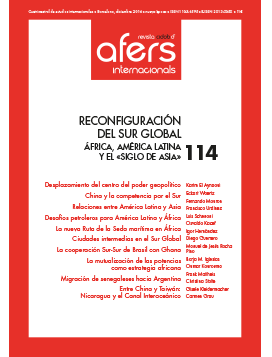Introducción: África, América Latina y el «siglo de Asia»
Resumen
Revista CIDOB d’Afers Internacionals, nº 114
Cuatrimestral (septiembre-diciembre 2016)
ISSN:1133-6595 | E-ISSN:2013-035X
DOI: https://doi.org/10.24241/rcai.2016.114.3.7
Desde la década de los ochenta del siglo pasado, en el sistema internacional se ha ido produciendo un desplazamiento continuo del centro del poder geopolítico desde Occidente hacia Asia-Pacífico; un cambio que, si en un primer momento fue económico, progresivamente se ha ido convirtiendo también en político y cultural. De esta manera, mientras los mercados emergentes asiáticos han ido ascendiendo en la cadena de valor de los procesos de producción industrial, la participación de los países industrializados occidentales en el PIB mundial ha ido disminuyendo. Recientemente, el PIB de China ha superado al de Estados Unidos y la UE en términos de paridad de poder adquisitivo, aunque sigue siendo considerablemente menor en dólares corrientes (véase la figura 1). Asimismo, además del G-7, ha surgido el G-20, que se ha convertido en una plataforma internacional para debatir los desafíos de la cooperación económica, si bien con un éxito variable. Países asiáticos como China e India también se están reafirmando en materia de seguridad, y buscan nuevas vías para los flujos de inversión y cooperación para el desarrollo.
Citas
Brautigam, Deborah. The Dragon’s Gift: The Real Story of China in Africa. Oxford, Nueva York: Oxford University Press, 2009.
Brautigam, Deborah. Will Africa Feed China? Oxford, Nueva York: Oxford University Press, 2015.
Christensen, Thomas J. The China Challenge: Shaping the Choices of a Rising Power. Nueva York: W.W. Norton, 2015.
Domínguez, Jorge I. y Covarubias, Ana (eds.). Routledge Handbook of Latin America in the World. Nueva York: Routledge, 2015.
Gallagher, Kevin P. The China Triangle: Latin America’s China Boom and the Fate of the Washington Consensus. Oxford y Nueva York: Oxford University Press, 2016.
Gallagher, Kevin P. y Porzecanski, Roberto. The Dragon in the Room: China and the Future of Latin American Industrialization Stanford: Stanford University Press, 2010.
IEA-International Energy Agency. World Energy Outlook 2015. París: OECD/IEA, 2015.
IMF-International Monetary Found. «World Economic Outlook Dataset».IMF (abril de 2016) (en línea) [Fecha de consulta: 02.11.2016] http://www.imf.org/external/pubs/ft/weo/2016/01/weodata/index.aspx
Kang, David C. China Rising: Peace, Power, and Order in East Asia. Nueva York: Columbia University Press, 2009.
Mattheis, Frank «Regionalism and Interregionalism: The Case of Latin America and Sub-Saharan Africa». Atlantic Future Project, Scientific Paper, n.º 23 (2015).
Shinn, David H. y Eisenman, Joshua China and Africa: A Century of Engagement Filadelfia: University of Pennsylvania Press, 2012.
The German Marshall Fund of the United States y OCP Policy Center. Atlantic Currents. An Annual Report on Wider Atlantic Perspectives and Patterns. Washington D. C. y Rabat: GMF y OCP, 2014.
United Nations. «World Population Prospects: The 2015 Revision».UN- Department of Economic and Social Affairs, 2015 (en línea) [Fecha de consulta: 02.11.2016] http://esa.un.org/unpd/wpp/
Woertz, Eckart (ed.). Reconfiguration of the Global South: Africa, Latin America and the ‘Asian Century’. Londres: Routledge, 2016.












